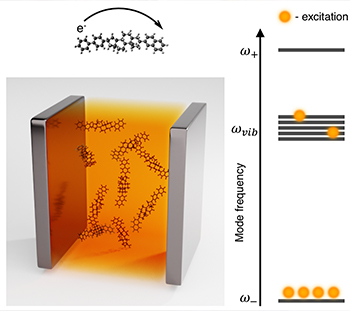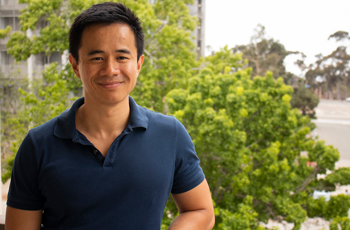Keck Foundation Supports Innovative Strategy for Chemical Synthesis
$1 million grant supports potentially transformational idea that could rewrite the way pharmaceuticals are developed
August 18, 2021 | By Mario Aguilera
 Image illustrates polariton condensation and its influence on chemical reactivity: The macroscopic occupation of an excited vibrational state can occur when many molecules are confined in an optical microcavity and pumped with a laser field. This phenomenon is known as polariton condensation and it can lead to new chemical processes that do not exist outside of a microcavity. Figure adapted from preprint S. Pannir-sivajothi, et al, arXiV:2106.12156.
Image illustrates polariton condensation and its influence on chemical reactivity: The macroscopic occupation of an excited vibrational state can occur when many molecules are confined in an optical microcavity and pumped with a laser field. This phenomenon is known as polariton condensation and it can lead to new chemical processes that do not exist outside of a microcavity. Figure adapted from preprint S. Pannir-sivajothi, et al, arXiV:2106.12156.
The 20th century invention of the laser, or light amplification by stimulated emission of radiation, unleashed a science and technology revolution, opening the floodgates to countless applications in society spanning from medicine to manufacturing to entertainment.
Scientists at UC San Diego and an interdisciplinary team of colleagues believe a new technology they are developing—known as “PASER,” or polariton amplification of stimulated-enhancement of reactions—offers similar potential to unleash waves of innovation.
PASER is a radical departure from the way that chemicals are currently synthesized. Instead of traditional physical-chemical manipulations, PASER organizes molecules by combining particles of light with vibrations of specific chemical bonds. The researchers believe that pharmaceutical drug development could be an immediate beneficiary of PASER technology.
“Just as lasers revolutionized science and technology by amplifying light with the same characteristics, a successful PASER demonstration could transform chemical synthesis by amplifying desired reaction pathways with unprecedented efficiency and specificity,” said lead principal investigator Joel Yuen-Zhou, an associate professor in the UC San Diego Department of Chemistry and Biochemistry.
Yuen-Zhou, a theoretical chemist, admits that the exploratory idea behind PASER is high on the risk-reward scale. However, the W.M. Keck Foundation found the idea tantalizing and stepped up to support a three-year, $1 million PASER demonstration plan.
At the heart of the plan is polaritonics, which is considered a middle ground between electronics and photonics. Instead of electric currents or light-based particles, polaritons are hybrids of light and matter. The idea behind PASER is rooted in developments originating in the mid-2000s, when condensed matter physicists developed breakthrough research that showed that an exotic state of matter known as the Bose-Einstein condensate, which is normally formed at ultracold temperatures, could instead be recreated in tabletop laser experiments at higher temperatures.
Yuen-Zhou and his research group members wondered if such exotic phenomena could be exploited from a chemical standpoint, something never before attempted. Their theoretical studies led by graduate student Sindhana Pannir-Sivajothi and including Jorge A. Campos-González-Angulo, Luis A. Martínez-Martínez and mathematics graduate student Shubham Sinha, currently under peer review, show great promise of this concept (a preprint of their work can be found at https://arxiv.org/abs/2106.12156).
“The PASER concept constitutes an unexplored intersection between photonics, polariton condensation and synthetic chemistry that could dramatically improve the efficiency and specificity of certain reactions,” the researchers noted in their project plan.
The researchers say their innovation is analogous to the developments leading to lasers, except that instead of energy accumulating in a photonic mode, it does so in the chemical bonds of a product molecule. Similar to the way lasers produce bright sources of photons with the same characteristics, the researchers expect PASERs to produce significant amounts of specific chemicals.
“Chemical synthesis is a multi-billion-dollar industry that requires high selectivity,” said Yuen-Zhou. “The pharmaceutical industry requires you to synthesize products very specifically. If we are able to use new optical elements to induce chemistry that is very efficient and selective—and it only produces particular products that we are interested in—then our innovation could potentially take off.”
 Joel Yuen-Zhou, associate professor in the UC San Diego Department of Chemistry and Biochemistry
Joel Yuen-Zhou, associate professor in the UC San Diego Department of Chemistry and Biochemistry
Joining Yuen-Zhou on the interdisciplinary team working to demonstrate the first PASERs are world leaders in polaritonics including Keith Nelson at MIT (ultrafast spectroscopy), Chris Giebink at Penn State University (organic photonics) and Mohammad Movassaghi, also at MIT (organic synthesis). Giebink will design and fabricate the photonic infrastructure, Movassaghi will lead the organic chemistry involved in PASER experiments and Nelson will coordinate ultrafast optical measurements. Yuen-Zhou will contribute theoretical guidance and modeling to help interpret the experimental results throughout the project.
The researchers will spend the first two years of the project developing materials and methods supporting the PASER concept, moving from simple systems such as water to more complex organic reactant molecules. The efforts are planned to culminate in the demonstration of PASERs and an “avalanche-style enhancement in the production of desired chemicals.”
Based in Los Angeles, the W. M. Keck Foundation was established in 1954 by the late W. M. Keck, founder of the Superior Oil Company. The Foundation’s grant making is focused primarily on pioneering efforts in the areas of medical research and science and engineering. The Foundation also supports undergraduate education and maintains a Southern California Grant Program that provides support for the Los Angeles community, with a special emphasis on children and youth. For more information, visit www.wmkeck.org
